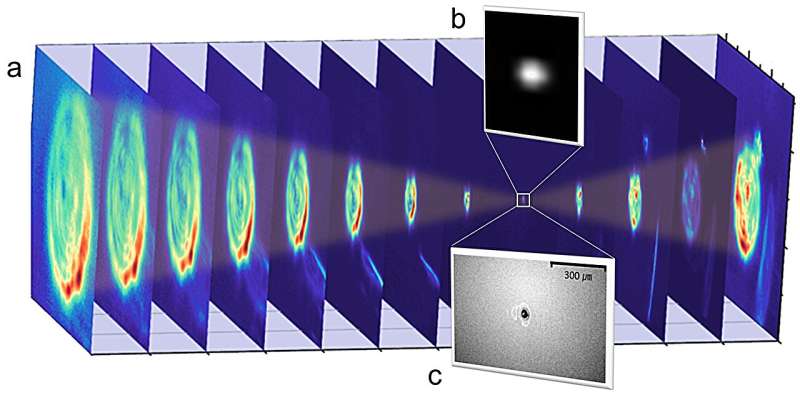This article has been reviewed according to Science X's editorial process and policies. Editors have highlighted the following attributes while ensuring the content's credibility:
fact-checked
peer-reviewed publication
trusted source
proofread
Researchers create the world's strongest ionizing terahertz radiation

Terahertz waves, known as non-ionizing radiation, can turn into ionization radiation when sufficiently many terahertz photons are focused in space and time. A team led by scientists in Korea and the U.S. has created the world's most intense terahertz pulses that can instantaneously ionize atoms and molecules and convert them into plasma.
The study, published in Light: Science & Applications, discusses terahertz-driven tunneling ionization, which will pave the way to extreme nonlinear and relativistic terahertz physics in plasmas.
Lying between the microwave and infrared regions of the electromagnetic spectrum, the terahertz (1 THz = 10¹² Hz) gap is being rapidly closed by development of new terahertz sources and detectors, with promising applications in spectroscopy, imaging, sensing, and communication.
These applications greatly benefit from terahertz sources delivering high-energy or high-average-power radiation. On the other hand, high-intensity or strong-field terahertz sources are essential to observe or exploit novel nonlinear terahertz-matter interactions, where the electric and/or magnetic field strengths play a key role.
The team of scientists, led by Dr. Chul Kang from Advanced Photonics Research Institute, Gwangju Institute of Science and Technology (GIST), Korea, and Professor Ki-Yong Kim from Institute for Research in Electronics and Applied Physics, University of Maryland, College Park, Maryland, U.S., has created the world's strongest terahertz fields of 260 megavolts per centimeter (MV/cm) or equivalent peak intensity of 9 x 10¹³ watts per square centimeter (W/cm²).
This peak field strength or intensity is the highest value achieved so far at terahertz frequencies (0.1~20 THz), including all types of terahertz sources utilizing lasers, free electron lasers, accelerators, and vacuum electronics.
To produce high-energy terahertz pulses, the scientists used a 150-terawatt-class Ti:sapphire laser to convert optical energy into terahertz radiation (so-called optical rectification) in lithium niobate (LiNbO₃), a crystal that exhibits strong nonlinearities and high damage thresholds. In particular, they used a large-diameter (75 mm) lithium niobate wafer, also doped with 5% magnesium oxide (MgO), to produce energy-up-scalable terahertz radiation.
For efficient conversion from optical to terahertz radiation, another important factor must be considered: phase (or velocity) matching. The scientists explained, "If the optical laser pulse that generates terahertz radiation propagates at the same velocity with the generated terahertz waves in lithium niobate, then the output terahertz energy can continuously grow with the propagation distance.
"Conventionally, a tilted pulse front method is used to satisfy phase matching in a prism-shaped lithium niobate. This method, however, produces mostly low-frequency terahertz radiation, typically peaked at less than 1 THz, which naturally leads to relatively large focal spot sizes (~mm), consequently limiting the peak terahertz field strength at the focus."
The team previously found a new phase matching condition in lithium niobate, which does not require any pulse front tilting. They noted, "The velocity of terahertz waves is generally frequency-dependent and varies so large between two phonon resonance frequencies that there exists a frequency at which both terahertz and laser pulses propagate at the same velocity.
"This occurs at approximately 15 THz for Ti:sapphire laser pulses having a central wavelength of 800 nm. This phase matching made it possible to produce millijoule-level terahertz waves. Moreover, the resulting 15-THz radiation can be tightly focused, potentially producing strong electromagnetic fields at the focus."
The scientists have carefully determined the peak electric and magnetic field strengths, 260 ± 20 MV/cm and 87 ± 7 T at the focus, by separately measuring the terahertz energy, focal spot size, and pulse duration.
"Such an intense terahertz pulse, when focused into a gaseous or solid medium, can tunnel ionize the constituent atoms or molecules, and convert the medium into a plasma. As proof of principle, we have demonstrated terahertz-driven ionization of various solid targets including metals, semiconductors, and polymers," they emphasized.
"Our terahertz source uses a planar lithium niobate crystal and is promising for scaling up the output energy and field strength even further. This can generate super-strong (~GV/cm) terahertz fields," they added.
The scientists believe that their research will open up new opportunities to not only study nonlinear effects in terahertz-produced plasmas but also utilize terahertz-driven ponderomotive forces for various applications including multi-keV terahertz harmonic generation and even studying relativistic effects by terahertz-accelerated electrons.
More information: Hyeongmun Kim et al, Ionizing terahertz waves with 260 MV/cm from scalable optical rectification, Light: Science & Applications (2024). DOI: 10.1038/s41377-024-01462-w
Journal information: Light: Science & Applications
Provided by Chinese Academy of Sciences




















